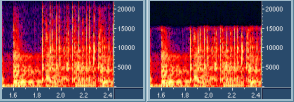Lowpass filter
lowpass filter is used to attenuate the higher frequencies, and "pass" the lower frequencies through. In perceptual audio coding it is used to lower the bitrate demand or to spare bits for the lower more important frequencies. Younger subjects can hear a loud sine wave up to 21-22kHz. The same subjects can't normally distinguish the difference between 19kHz lowpassed music and non-lowpassed music.

The figure on the left side does not have a any lowpass used, while the figure on the right is signal filtered with 15kHz lowpass filter.

The figure on the left side does not use lowpass, while the figure on the right is signal filtered with 15kHz lowpass filter.
Digital filters
There are several different ways to implement lowpass filters. The three most commonly used types, both in hardware and software implementations are:
Each of these filters have their own advantages and disadvantages, depeneding upon the applications that they are being used for. The Chebyshev filter is considered "maximally flat", while Buttworth filter has the steepest roll-off. The Bessel filter is the most commonly used in audio signal processing due to the fact that it is a "linear phase" filter, meaning that it is free of any artifacts. This is compared in stark contrast to that of the Chebyshev filter.
